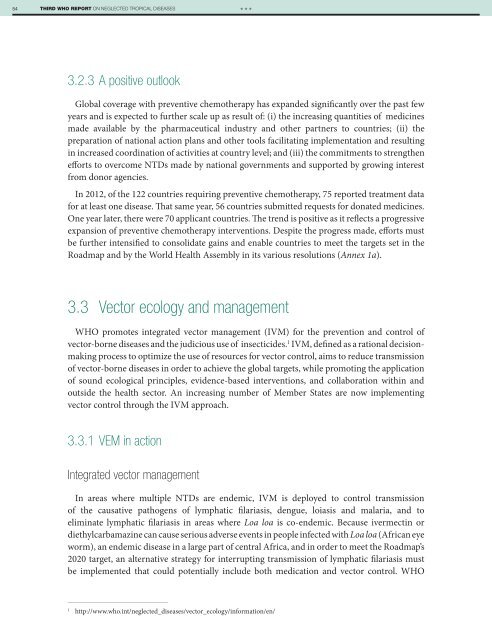1A9bnbK
1A9bnbK
1A9bnbK
You also want an ePaper? Increase the reach of your titles
YUMPU automatically turns print PDFs into web optimized ePapers that Google loves.
54 THIRD WHO REPORT ON NEGLECTED TROPICAL DISEASES<br />
***<br />
3.2.3 A positive outlook<br />
Global coverage with preventive chemotherapy has expanded significantly over the past few<br />
years and is expected to further scale up as result of: (i) the increasing quantities of medicines<br />
made available by the pharmaceutical industry and other partners to countries; (ii) the<br />
preparation of national action plans and other tools facilitating implementation and resulting<br />
in increased coordination of activities at country level; and (iii) the commitments to strengthen<br />
efforts to overcome NTDs made by national governments and supported by growing interest<br />
from donor agencies.<br />
In 2012, of the 122 countries requiring preventive chemotherapy, 75 reported treatment data<br />
for at least one disease. That same year, 56 countries submitted requests for donated medicines.<br />
One year later, there were 70 applicant countries. The trend is positive as it reflects a progressive<br />
expansion of preventive chemotherapy interventions. Despite the progress made, efforts must<br />
be further intensified to consolidate gains and enable countries to meet the targets set in the<br />
Roadmap and by the World Health Assembly in its various resolutions (Annex 1a).<br />
3.3 Vector ecology and management<br />
WHO promotes integrated vector management (IVM) for the prevention and control of<br />
vector-borne diseases and the judicious use of insecticides. 1 IVM, defined as a rational decisionmaking<br />
process to optimize the use of resources for vector control, aims to reduce transmission<br />
of vector-borne diseases in order to achieve the global targets, while promoting the application<br />
of sound ecological principles, evidence-based interventions, and collaboration within and<br />
outside the health sector. An increasing number of Member States are now implementing<br />
vector control through the IVM approach.<br />
3.3.1 VEM in action<br />
Integrated vector management<br />
In areas where multiple NTDs are endemic, IVM is deployed to control transmission<br />
of the causative pathogens of lymphatic filariasis, dengue, loiasis and malaria, and to<br />
eliminate lymphatic filariasis in areas where Loa loa is co-endemic. Because ivermectin or<br />
diethylcarbamazine can cause serious adverse events in people infected with Loa loa (African eye<br />
worm), an endemic disease in a large part of central Africa, and in order to meet the Roadmap’s<br />
2020 target, an alternative strategy for interrupting transmission of lymphatic filariasis must<br />
be implemented that could potentially include both medication and vector control. WHO<br />
_____________________<br />
1<br />
http://www.who.int/neglected_diseases/vector_ecology/information/en/


